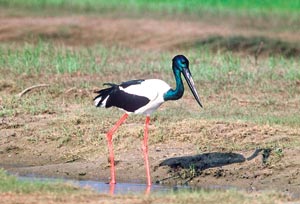Kokkilai was the scene of a horrific massacre in 1984 when the LTTE killed over a hundred innocent civilians including fishermen. The war is over, but this time another war is being unleashed in the Kokkilai Sanctuary – a war against nature. A large forested area in and around the western side of Kokkilai Lagoon has been cleared using heavy machinery since last week. Some people from Pulmoddai in the Kuchaveli area are behind this destruction, according to local sources.
Sajeewa Chamikara of the Sri Lanka Nature Forum said forest areas right upto the edge of the lagoon are being cleared. “There could be a big impact on wildlife, especially birds, if the encroachment continues,” Sajeewa who visited Thillamaranwadiya in Kuchaveli on Thursday together with a team of concerned people says. About 40 acres have already been cleared and some patches in other areas too are being cleared, including some mangrove forests.
 |
| The rare black-necked Stork photographed at Kokkilai. Pic by Zero3 Image |
According to government regulations, anyone clearing more than one hectare of forest land has to obtain an environmental impact assessment licence and get relevant approval from the CEA and the project approving authority. “But if the land is in a sanctuary or within 100 metres from the border of a sanctuary, even a clearance of a lesser extent has to follow the same procedure,” points out environmental lawyer Jagath Gunawardane. “The recent Kokkilai encroachment violates these; it is an illegal activity which should be stopped immediately,” he said.
The Kokkilai Lagoon and its vicinity is one of the oldest protected areas in Sri Lanka having been declared a sanctuary on May 18, 1951, almost 59 years ago. The 2,995 hectare protected area consists of estuaries, deltas, intertidal mudflats, sand flats, mangrove swamps and mangrove forest. The sanctuary cuts across the boundaries of both Trincomalee and Mullaitivu Districts belonging to both Northern and Eastern Provinces. The sanctuary is surrounded partly by privately owned lands and some of these private ownerships are being used as a cover-up for the illegal clearance.
Local fishermen are against the clearing and are worried that this will affect their livelihood in the long run. Clearing forests will lead to soil erosion and result in the lagoon being subjected to sedimentation. This will affect the fish and prawns of Kokkilai lagoon. “There are over 1500 families who earn their livelihood by fishing in the Kokkilai lagoon. If the lagoon is affected, then it will be a socio-economic problem too,” says Thilak Hittigedara, a member of the Sri Pura Pradeshiya Sabha. Fishermen from Kokkilai, Pulmoddai and Sri Pura traditionally live off lagoon fishing. Before the war, a group of migratory fishermen had also joined those residing in Kokkilai.
“Though the relevant authorities have been informed about this destruction, still no action has been taken,” says Thilak. The wildlife officers of the area had visited Kokkilai lagoon on Thursday, but were not available for comment. Environmental Ministry sources said the new minister had also raised this issue in Parliament.
Kokkilai has been famous as a bird paradise especially during the migratory period. Birds that migrate to Sri Lanka on the Eastern route find Kokkilai a haven. The war prevented authorities from reassessing the status of the Kokkilai sanctuary durin the past few decades, but the environment group Eco-friendly Volunteers (Eco-V); had done research on the spot-billed Pelican in Kokkilai lagoon during the period 2004 – 2007 with the support of the Army.
President of Eco-V, Kanchana Weerakoon, confirmed that Kokkilai was a bird paradise even during war time, with the rare Black-necked Stork being regularly seen on the lagoon. Kanchana also pointed out that the mangroves in the lagoon are a major roosting habitat for thousands of Egrets, Gray Herons, Ibis and Cormorants. The cleared areas included roosting and nesting sites of the Kokkilai birds, Sajeewa says.
Encroachment in Somawathi too
Kokkilai is not the only sanctuary under threat. Somawathi National Park in the Eastern Province has also been subjected to illegal encroachment after the war. An area in Aluthwewa inside the National Park has been cleared by illegal encroachers, allegedly backed by a local politician.
On April 26, on a tip received by the park warden of Kaudulla National Park, some 32 wildlife officers escorted by police raided this illegal construction site and seized a backhoe used to clear the area. While returning, a group of villagers backed by the local politico had threatened the team and damaged some of their vehicles. The wildlife officers together with police later arrested a group of culprits.
A road that goes about 12 km inside the jungle, has been built to carry heavy vehicles and the encroachers are aiming to use the cleared land for agriculture. A canal was also being dug with a backhoe to make use of Mahaweli waters, according to the Kaudulla park officers.
Protected Areas in the North and East escaped the axe of development for a long time but this is already changing, encroachment and other illegal activities show signs of jeopardizing the planned development of the North and East.
|


